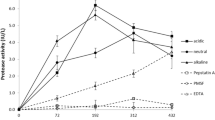Abstract
This article focuses on the relation between laccase-secreting ability and growing cycle in the edible fungi. First, laccase activities of fifteen different edible fungi were detected and determined by plate assay and spectrophotometric method using 2,2′-azinobis(3-ethylbenzothiazoline-6-sulfonic acid) as the substrate. The results showed the laccase-secreting ability in the edible fungi and their growing cycles are closely related. The edible fungi strains with short growing cycles originate from their high levels of secreted laccase activity. However, those strains require long growing cycles due to the low levels of secreted laccase, even no detectable laccase activity. The research provides the first evidence on the corresponding relation between the level of secreted laccase activity and growth cycles of edible fungi. Our study has significantly increased the understanding of the role of laccase in the growth and development of edible fungi.
Similar content being viewed by others
References
Archibald F, Roy B (1992) Production of manganic chelates by laccase from the lignin-degrading fungus Trametes (Coriolus) versicolor. Appl Environ Microbiol 58:1496–1499
Bollag JM, Shuttleworth KL, Anderson DH (1988) Laccase-mediated detoxification of phenolic compounds. Appl Environ Microbiol 54:3086–3091
Chen JF, Zhang XP (2006) Guide for edible mushroom cultivation. China Agricultural Science and Technology Press, Beijing
Chen S, Ge W, Buswell JA (2004) Molecular cloning of a new laccase from the edible straw mushroom Volvariella volvacea: possible involvement in fruit body development. FEMS Microbiol Lett 230:171–176
Chen S, Ma D, Ge W, Buswell JA (2003) Induction of laccase activity in the edible straw mushroom, Volvariella volvacea. FEMS Microbiol Lett 218:143–148
Das N, Sengupta S, Mukherjee M (1997) Importance of laccase in vegetative growth of Pleurotus florida. Appl Environ Microbiol 63:4120–4122
Eggert C, LaFayette PR, Temp U, Eriksson KE, Dean JF (1998) Molecular analysis of a laccase gene from the white rot fungus Pycnoporus cinnabarinus. Appl Environ Microbiol 64:1766–1772
Eggert C, Temp U, Eriksson KE (1997) Laccase is essential for lignin degradation by the white-rot fungus Pycnoporus cinnabarinus. FEBS Lett 407:89–92
Eichlerova I, Ruel K, Homolka L, Joseleau JP, Nerud F (2000) Ligninolytic characteristics of Pleurotus ostreatus strain F6 and its monokaryotic protoplast derivative P19. Can J Microbiol 46:1153–1158
Fukushima Y, Kirk TK (1995) Laccase component of the Ceriporiopsis subvermispora lignin-degrading system. Appl Environ Microbiol 61:872–876
Guo CJ (2009) High efficient cultivation technology of edible mushrooms. Chemical Industry Press, Beijing
Huang Y (2008) Cultivation of edible mushroom, 3rd edn. Higher Education Press, Beijing
Kahraman SS, Gurdal IH (2002) Effect of synthetic and natural culture media on laccase production by white rot fungi. Bioresour Technol 82:215–217
Leatham GF (1985) Extracellular enzymes produced by the cultivated mushroom Lentinus edodes during degradation of a lignocellulosic medium. Appl Environ Microbiol 50:859–867
Liu LH, Lin ZW, Zheng T, Lin L, Zheng CQ, Lin ZX, Wang SH, Wang ZH (2009) Fermentation optimization and characterization of the laccase from Pleurotus ostreatus strain 10969. Enzym Microb Technol 44:426–433
Mayer AM, Staples RC (2002) Laccase: new functions for an old enzyme. Phytochem 60:551–565
Nagai M, Kawata M, Watanabe H, Ogawa M, Saito K, Takesawa T, Kanda K, Sato T (2003) Important role of fungal intracellular laccase for melanin synthesis: purification and characterization of an intracellular laccase from Lentinula edodes fruit bodies. Microbiol 149:2455–2462
Nagai M, Sato T, Watanabe H, Saito K, Kawata M, Enei H (2002) Purification and characterization of an extracellular laccase from the edible mushroom Lentinula edodes, and decolorization of chemically different dyes. Appl Microbiol Biotechnol 60:327–335
Ohga S, Royse DJ (2001) Transcriptional regulation of laccase and cellulase genes during growth and fruiting of Lentinula edodes on supplemented sawdust. FEMS Microbiol Lett 201:111–115
Pan CH, Gong X, Qian ZG (2006) Rare edible fungi cultivation and exploitation and utilization of wild edible mushrooms. China Agricultural Press, Beijing
Srinivasan C, Dsouza TM, Boominathan K, Reddy CA (1995) Demonstration of laccase in the white rot basidiomycete Phanerochaete chrysosporium BKM-F1767. Appl Environ Microbiol 61:4274–4277
Turner EM, Wright M, Ward T, Osborne DJ, Self R (1975) Production of ethylene and other volatiles and changes in cellulase and laccase activities during the life cycle of the cultivated mushroom, Agaricus bisporus. J Gen Microbiol 91:167–176
Zhao J, Kwan HS (1999) Characterization, molecular cloning, and differential expression analysis of laccase genes from the edible mushroom Lentinula edodes. Appl Environ Microbiol 65:4908–4913
Acknowledgments
This work was financially supported by the Natural Science Foundation and the Key Program of Fujian Province of China (No. 2009J05046, 2009N0010 and 2010N0004) and Science Fund of the Provincial Education Department of Fujian Province of China (No. JA09098).
Author information
Authors and Affiliations
Corresponding author
Rights and permissions
About this article
Cite this article
Sun, S.J., Liu, J.Z., Hu, K.H. et al. The Level of Secreted Laccase Activity in the Edible Fungi and their Growing Cycles are Closely Related. Curr Microbiol 62, 871–875 (2011). https://doi.org/10.1007/s00284-010-9794-z
Received:
Accepted:
Published:
Issue Date:
DOI: https://doi.org/10.1007/s00284-010-9794-z




